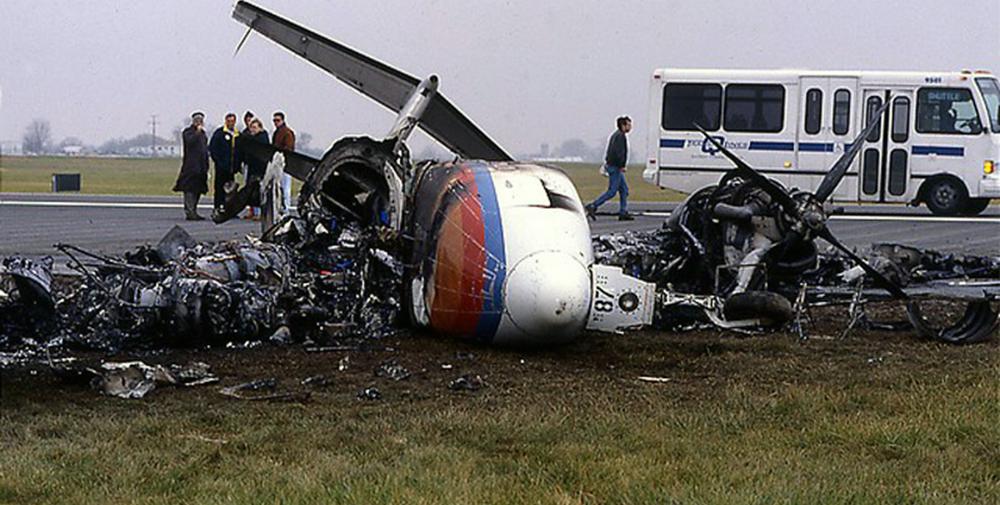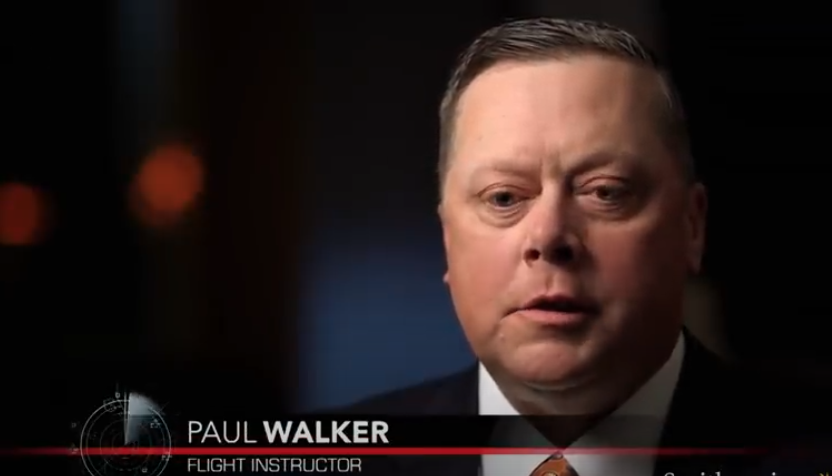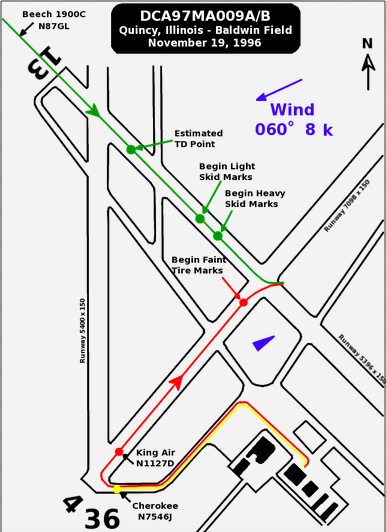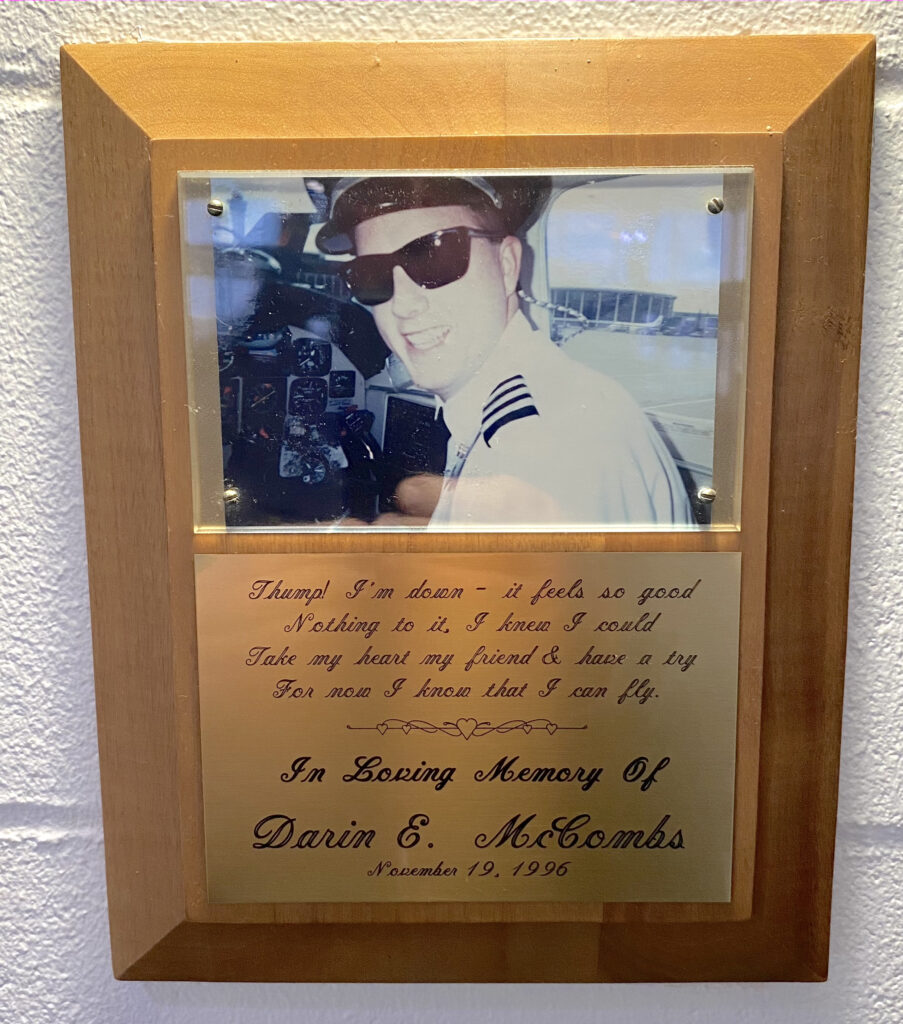‘Helpless and shocked’: Collision of airplanes on runway 25 years ago deadliest incident in Quincy history

QUINCY — Chuck Scholz fondly remembers most of his time as Quincy’s mayor from 1993 to 2005.
He doesn’t hesitate, however, when asked which day was his worst.
Tuesday, Nov. 19, 1996.
5:02 p.m.
Twenty-five years ago today.
United Express Flight 5925, a Beechcraft 1900 twin turboprop plane, collided as it tried to land with a King Air private plane shortly after 5 p.m. on a runway at Baldwin Field. Both planes burst into flames. Fourteen people died — 10 passengers and two pilots on the Beechcraft 1900, and two pilots on the King Air.
That crash is the deadliest incident in Quincy history. The previous most tragic accident was the deaths of 12 schoolgirls in a fire at St. Francis School, 18th and College, on Dec. 22, 1899. The fire occurred when the girls were rehearsing for an upcoming Christmas program in the school auditorium.
“I remember exactly where I was when I found out,” Scholz said of the plane crash. “I was in the basement of the WCU (510 Maine) at some meeting. Maybe it was for Chaddock or something, but the idea was we have to recruit more foster parents. Then my cellphone went off … crash at the airport. I left the meeting (and) drove out there fast as I could. I felt very helpless and shocked.”
Officials from the National Transportation Safety Board eventually took over the investigation of the crash, but Scholz said they didn’t arrive at the airport for several hours. He said Jason Simmons, a police officer with the Quincy Police Department, was in charge of the scene.
“The first thing we were trying to do is determine: Who are these people?” Scholz said. “We knew he had 14 fatalities. Who’s supposed to be on that plane? Because sometimes people don’t get on the plane, and sometimes somebody else gets on.
“We didn’t think anyone was from Quincy. Gosh, they were from all over. We had families who had heard about the crash and contacted us, but we just can’t say, ‘That was your loved one.’ I was very grateful to have Jason there with me. We did what we had to do as far as securing the site. I think Rod Cookson (with Zehender Robinson Stormer Cookson Funeral Home in Quincy) helped set up a temporary morgue out there in the back of a refrigerated semi or something.”
Scholz tried to handle press requests until the NTSB officials arrived.
“I think I made one statement, which was, ‘We’re not going to make any statements because we’re waiting for the NTSB,’ ” he said.

Flight instructor: ‘I felt like I failed’
The United Express flight left Chicago’s O’Hare Airport at 3:25 p.m., scheduled to stop in Burlington, Iowa, before arriving in Quincy.
Less than two hours before the crash, firefighters from the Quincy and Central Adams fire departments were at Baldwin Field to cover the landing and takeoff of a charter MD-87 bound for Las Vegas with 100 passengers. The MD-87 had been delayed 45 minutes for a safety inspection by the Federal Aviation Administration.
United Express was forced to stay on the ground in Burlington for at least one hour after the charter left Quincy.
The Associated Press reported the United Express plane, piloted by Kate Gathje, had just landed when it collided with the smaller King Air plane, piloted by Neal Reinwald. The St. Louis Post-Dispatch reported at the time that Reinwald was giving a lesson to Laura Winkleman Brooks when the crash occurred. The private plane was from the St. Louis Downtown-Parks Airport in Cahokia, Ill. It had flown from Quincy to Tulsa, Okla., and back that day. It was headed back to the Cahokia airport.
The United Express plane was sheared in half. One firefighter said seven bodies were found stacked inside the door, indicating passengers made a frantic bid to escape in the seconds before the plane exploded.
Bruce Chandler, a part-time airport maintenance worker, told the Quincy Herald-Whig he ran to the plane, where flames were shooting 100 feet high.
“I ran outside to see if I could help,” Chandler said. “I got 20 feet away, and I could hear people inside screaming and yelling.”
Paul Walker, a flight instructor, was at the airport that night. He told the Smithsonian Channel in an interview posted online in 2017 that he was “a minute and a half” from the crash site.
The website Admiral_Cloudberg.medium.com, which analyzes plane crashes, reported that as Walker approached the plane, he could see and hear people moving about inside. He then saw Gathje stick her heard out of the cockpit window and pleaded with him to “get that door open.” He tried to open the door but failed.
“I tried everything that I could do in the world, and I could not get that door to unlatch,” he said. “Leaving the airplane was one of more difficult things I’ve ever done in my life. When I looked at the captain, there was part of me that knows that she knew that by the time I got back, it would be too late … that I was literally their last hope.”
As Walker ran from the plane to get help, the plane exploded.
“It was easily less than two minutes from the time I was standing by the left wing until it exploded,” he said. “I felt like I failed.”
NTSB: Probable cause was failure of King Air pilots to monitor traffic advisory frequency
Runway skidmarks showed the pilots desperately trying to avoid colliding.
“The skidmarks left by the United Express aircraft would seem to indicate … the pilot could see something was about to happen,” said George Black, who oversaw the investigation by the NTSB. “The other set of tire marks would seem to indicate the King Air tried to avoid the crash at the last minute, but it was too late.”
A third plane, a Piper Cherokee with a pilot and passenger, also was taxiing the runway behind the King Air plane. The NTSB report about the crash, released in September 2000, said the radio transmission between the Beechcraft 1900 plane and the King Air plane was interrupted by the pilot of the Cherokee, who had only 80 flight hours and was inexperienced with radio etiquette.

The Associated Press reported that pilots at small airports without control towers were required to broadcast their positions repeatedly as they approached, prepared to take off or taxied down the runway. The broadcasts went out over an open channel that all planes near uncontrolled airports monitor.
“(The interrupted radio transmission) led to the Beech 1900C pilots’ misunderstanding of the transmission as an indication from the King Air that it would not take off until after flight 5925 had cleared the runway,” the report read.
Fatigue also may have been a factor. Gathje and Darin McCombs, the first officer on the United Express flight, had clocked in that morning at 4:15 a.m. and had been on duty for nearly 13 hours. They flew from Bloomington, Ind., to Terre Haute, Ind., to Chicago and Burlington, Iowa, before arriving in Quincy.
The NTSB determined the probable cause of the accident was “the failure of the pilots in the King Air A90 to effectively monitor the common traffic advisory frequency or to properly scan for traffic, resulting in their commencing a takeoff roll when the Beech 1900C was landing on an intersecting runway.”
The NTSB also said the lack of adequate aircraft rescue and firefighting services, and the failure of the air stair door on the Beech 1900C to open, contributed to the severity of the accident and the loss of life.
As a result of the accident, the NTSB issued several recommendations, including:
- the FAA reiterate to flight instructors the importance of scanning for traffic;
- the FAA reevaluate the jamming characteristics of the Beech 1900 air stair door;
- the freedom from jamming requirements be clarified;
- and small airports that receive commercial flights have firefighters on duty for landings and takeoffs of airplanes with as few as 10 passenger seats, rather than 30.
The bodies of the 14 deceased people were left on the runway overnight at Baldwin Field before being removed the following morning.
Salvation Army major helped grieving families for three days
Scholz was at the airport for about 3 1/2 hours that fateful night before he was told the NTSB officials would handle the investigation. He’ll never forget one person’s efforts in the wake of the tragedy.
“Herb Fuqua was the Salvation Army major for Quincy at the time,” Scholz said. “I had tried to call a couple other guys first who weren’t available. When I reached Herb, I said, ‘You’ve got to come out here right away.’ He was amazing. He stayed (at the airport) the whole time. For 72 hours, he never left. It took three days for the grieving families to arrive. We gave him the conference room (at the airport), and that’s what he operated out of for three days. He prayed for families and offered comfort.
“At the end of all of it, I said to him, ‘Herb, I never could have got through this without you. I don’t know how I’m ever gonna be able to thank you.’ And he looks at me and says, ‘No, thank you. This is what I’m called to do.’”
The only memorial at the airport is a small plaque hanging on the wall next to the stairway to the airport restaurant. It has a photo of a grinning McCombs in the cockpit of a plane. It reads:
Thump! I’m down — it feels so good
Nothing to it, I knew I could
Take my heart, my friend, and have a try
For now I know that I can fly.
In loving memory of Darin E. McCombs
Nov. 19, 1996

Who died in the crash?
A list of passengers and crew members killed aboard United Express Flight 5925, as well as the pilots on the King Air 90.
United Express Passengers
- Mike Brueck, 50. Brueck was the production manager at Tuthill Corp.’s Murray Turbomachinery Division in Burlington, Iowa. He worked for 32 years for a company which made steam turbines. He was from Burlington.
- Leonard Carlson, 53. was the production manager at Tuthill Corp.’s Murray Turbomachinery Division. He worked there for 36 years. He was from Wever, Iowa.
- William Johnson, age unknown, was a machine specialist at Tuthill Corp.’s Murray Turbomachinery Division. He worked there for 22 years in the factory. Brueck, Carlson and Johnson were on their way to Massachusetts to see a new piece of equipment for the factory. Johnson was from Danville, Iowa.
- James Beville, 50. Beville was the president of Dielectric Communications in Raymond, Maine. He was coming to Quincy to meet with Harris Corp. Broadcast Division officials. He left behind a wife and three sons.
- Mark DeSalle, 43. DeSalle was the vice president of finance for Dielectric Communications in Raymond, Maine. He was coming to Quincy to meet with Harris Corp. Broadcast Division officials. He left behind a wife and a son.
- Larry Downing, 57. Downing was a general vice president of the International Association of Machinists and Aerospace Workers in Des Plaines. He was on his way to Quincy for a meeting with the IAM Local 822. He was scheduled to be on a later flight, but when a seat became available on the United Express flight, he took it. Downing lived in Palatine. He left behind a wife, a son and two daughters.
- Dennis Reed, 37. Reed was the director of international programs for Harris Broadcasting in Cincinnati. He worked out of Florence, Ky., and was on his way to Quincy for a business meeting. He left behind two children and a wife.
- Edward Schneggenburger, 32. Schneggenburger, an application engineer for Rotork Control Corp. in Rochester, N.Y., was on his way home after an overnight business trip in Iowa. The native of Amherst, N.Y., left behind two children, ages 4 and 2, and his wife was expecting a third child at the time.
- Jason Berger, age unknown. Berger was an attorney at the law practice of Testa Hurwitz and Thibeault out of Boston.
- Debbie Heffelbower, 44. Heffelbower was a surveyor for Home Health Care accreditation service based in Chicago. The job took her all over the country surveying other home health care agencies. She lived in Burlington, Iowa.
United Express Crew
- Katherine Gathje, 30. Gathje, from Rochester, Minn., was the captain of the flight and had flown commuter planes for three years. She had been promoted to captain a year earlier. She got her pilot’s license at age 18.
- Darin McCombs, 24. McCombs was the first officer of the flight. He was from New Windsor, Ill. His engagement to get married was announced just a few months earlier.
King Air Crew
- Neal Reinwald, 63. Reinwald was a retired TWA captain and a pilot in the U.S. Air Force Reserve. He had accumulated more than 25,000 hours of total flight time. He had been flying the King Air between Quincy and Tulsa, Okla., to introduce the plane to potential buyers.
- Laura Winkleman Brooks, 34. Brooks was employed by FlightSafety International Airline Center in St. Louis, She was a ground instructor and a part-time CFI at the same Air Force aero club as Reinwald. She had nearly 1,500 hours and was working to build multiengine experience for an airline job. The flight was her first in a King Air.
EDITOR’S NOTE: Some information for this story was reported by The Quincy Herald-Whig in its Nov. 20, 21 and 22 issues in 1996.
Miss Clipping Out Stories to Save for Later?
Click the Purchase Story button below to order a print of this story. We will print it for you on matte photo paper to keep forever.

